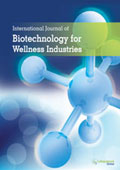ijbwi
Abstract : A Comparative Study between Response Surface Methodology and Genetic Algorithm in Optimization and Extraction of Leaf Protein Concentrate from Diplazium esculentum of Assam
|
|
Abstract: Fern is a seedless vascular plant that reproduces via spores and has various usefulness. This study was carried out to optimize the conditions of leaf protein concentrate extraction using ultrasound from defatted fern type Diplazium esculentum. The extraction of defatted fern protein was conducted using ultrasound. Rotatable central composite design (RCCD) of response surface methodology was used for identification of the best condition and extraction yield optimization. An attempt with genetic algorithm optimization was also carried out and revealed that optimized results were of highest desirability as compared to response surface methodology. The final optimum results, by using genetic algorithm was observed to be 21.12 min of sonication time, 56.88 °C temperature, 7.59 pH and 66.2 ml of solvent for an optimum protein yield of 33.79% where desirability value was 1.00. UHPLC analysis of the sample revealed the presence of all the essential amino acids, except tryptophan. Keywords: Leaf protein concentrate, Diplazium esculentum, GA, Optimization, Response surface methodology, Genetic algorithm.Download Full Article |
Abstract : Circular Economy: A New Horizon for Bio-Nanocomposites from Waste Materials
|
|
Download Full Article |
Abstract : Toxicological Effect of Lauric Acid Based Insecticide on the Reproduction System, Growth Development and Feeding Activity of Aphids, Aphis gossypii Glover
|
|
Abstract: The toxicological effect of lauric acid based insecticide was investigated in terms of mode of action on aphids target system. Treated leaves were sprayed with different insecticides, which were lauric acid, cinnamaldehyde and malathion at 50µg/ml concentration to compare the effect of the pesticides on reproduction, growth development and feeding activity of aphids. The total number of new born nymphs produced and the relative development stage of nymphs were significantly reduced in all treatments compared to untreated leaves. Number of new born nymphs treated using lauric acid based pesticide was 6.0 ± 1.41 nymphs/day and the growth development rate at second day post treatment was rDS=1.07 ± 0.10. This data showed no significant difference with the data obtained when cinnamaldehyde and malathion were used aspositive controls but the results were significantly different from the results obtained using untreated leaves (22.5 ± 3.54 nymphs/day, rDS=1.82 ± 0.02). Lauric acid was also shown to reduce the feeding activity of aphids. The study demonstrated that lauric acid was toxic to aphids. It has the ability to slow down the reproduction system, reduce growth development rate and decrease feeding activity of aphids (Aphis gosyypii Glover). Keywords: Aphis gossypii, Lauric acid, Insecticides, Toxicological effect.Download Full Article |
Abstract : Bioremediation of Hexavalent Chromium in Potassium Dichromate Solution by Botrytis aclada fres and Chrysonilia sitophila
|
|
Abstract: Bioremediation of hexavalent chromium, Cr(VI) by Botrytis aclada fres and Chrysonilia sitophila was studied. The organisms were isolated from decaying onion bulb and apple fruit respectively, purified in Potato Dextrose Agar, and grown for 144 hours in solutions of potassium dichromate of concentrations ranging from 5-20 mg/l at 400C. Effective reduction of Cr(VI) was observed at 5-20 mg/l compared to 25 mg/l dichromate treatments in both organisms. The results showed significant decrease (P < 0.05) in biomass concentration in the two fungi used with increasing concentration of the dichromate treatment (5-25 mg/l). Significant increase (P < 0.05) in residual glucose concentration was also observed in the culture media with increase in concentration of the dichromate treatment. However, at 20 mg/l dichromate treatment, Cr(IV) concentration, 1.36 ± 0.02 and 1.71 ± 0.03 (P < 0.05) were revealed in the culture media of B. aclada fres and C. sitophila respectively. Also, 0.71 ± 0.03 and 0.94 ± 0.03 Cr(IV) concentration (P < 0.05) were observed in the fungal mycelia at 20 mg/l dichromate treatment in B. aclada fres and C. sitophila respectively. After 144 hours of growth, Cr(VI) reduction of 89.65% in B. aclada fres and 86.75% in C. sitophila at 20 mg/l dichromate treatment were revealed. This investigation suggests that the two fungi adopted a process of reduction to tolerate the toxicity of hexavalent chromium. The results indicate the potentials of the fungi in bioremediation particularly in the treatment of waste water containing hexavalent chromium.. Keywords: Chromium contamination, Cr(VI) reduction, detoxification, waste water treatment, Botrytis aclada fres, Chrysonilia sitophila.Download Full Article |























